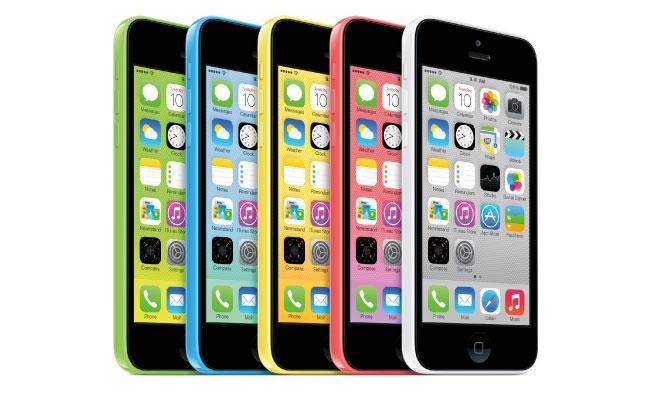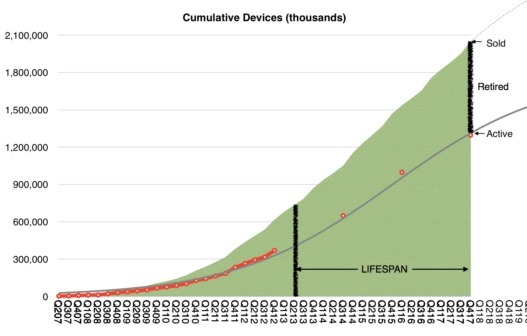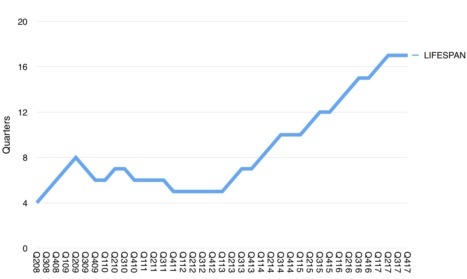The average lifespan of an Apple device is probably just over four years, according to analysis into figures released during the fourth quarter investor conference call, suggesting that iPhones and iPads remain in active use for twice as long as the typical consumer iPhone upgrade cycle.
The analysis by Asymco's Horace Dediu is based on figures provided by Apple each quarter specifically the number of devices it sells. It is also based on another rare figure revealed by Apple during the financial results, namely that it had grown its active install base to 1.3 billion devices, representing a 30 percent growth over two years.
This latter figure is the second time Apple revealed its active installation base, with the first being when it hit the 1 billion active device milestone, as part of the results released in January 2016.
Dediu advises that by knowing the number of active devices, as well as the cumulative number of devices sold, it can be used to approximate the average device lifespan.
To do so, he created a graph to show the total number of devices Apple sold since the second quarter of 2007, followed by a curve to show approximately how many active devices there are, based on Apple's released figures. For a particular quarter, the area of the graph below the line relates to the number of active devices, while the area between the active device curve and the number of devices sold determines how many devices have been retired since 2007.
The approximate lifespan of a series of devices is said to be when the cumulative number of devices sold in the quarter equates to the amount of retired devices in a later quarter. The duration between the two can effectively be taken as an estimated average lifespan for the devices.
To work out the estimate lifespan of devices retired in the recent quarter, Dediu determines the number of retired devices to be 750 million, namely 2.05 billion cumulative sales minus 1.3 billion active devices. This is then compared to earlier quarters until it is close to the number of cumulative devices sold.
"The lifespan is thus estimated at the time between now and Q3 2013, or 17 quarters or about 4 years and three months," advises Dediu.
The cumulative devices calculation includes Macs, iPhones, iPads, iPod Touch, and the Apple Watch. As such, the calculations cannot be broken down to individual product categories, and considering some hardware types would be assumed to be used for longer than others, it would be hard to work out these figures without Apple providing more detailed statistics, something it is unlikely to provide anytime soon.
A second graph by Dediu maps the average lifespan for devices retired in a particular quarter, based on the first graph. Notably, the graph seems to show the average lifespan increasing every few quarters since 2012, breaking four years in early 2017, and seemingly indicates the trend of using Apple devices for longer periods of time will continue for a while longer.
 Malcolm Owen
Malcolm Owen









-m.jpg)






 Marko Zivkovic
Marko Zivkovic
 Christine McKee
Christine McKee
 Andrew Orr
Andrew Orr
 Andrew O'Hara
Andrew O'Hara
 William Gallagher
William Gallagher

 Mike Wuerthele
Mike Wuerthele
 Bon Adamson
Bon Adamson


-m.jpg)


44 Comments
I find these statistics interesting. I have a 2g iPod touch that I chiefly use to serve drum/bass tracks when I'm shrieking and whaling on my gitter. ("Whoops, it hit the sticky floor again. Ohs well.") I've wondered if that's an active device since it's on my Apple ID, or if hits on teh Interwebs or some such are required for that status.
I'm reading this on my 7+ year old iMac. Still chugging along.
4 years average sounds about right in our iOS device ownership. The only reason it would be sooner is irrecoverable device failure.
Now that battery age is in the minds of the public, and more people are changing out batteries, the average age will only tick up.
My MacBook Pro is now 7 years old — retired to pure backup system, but still there.
My old iPad 2 is what — six years old? Still running fine as my daughter's primary computer.
My living-room iMac/TV is ten years old. Working fine, 24/7.
My iPod 1st generation is now 17 years old and still running fine.
My iPod classic is — gosh, ten years old? Twelve? Works fine.
My iPhones, I sell off and don't keep track of.
Hm. Am I an outlier?